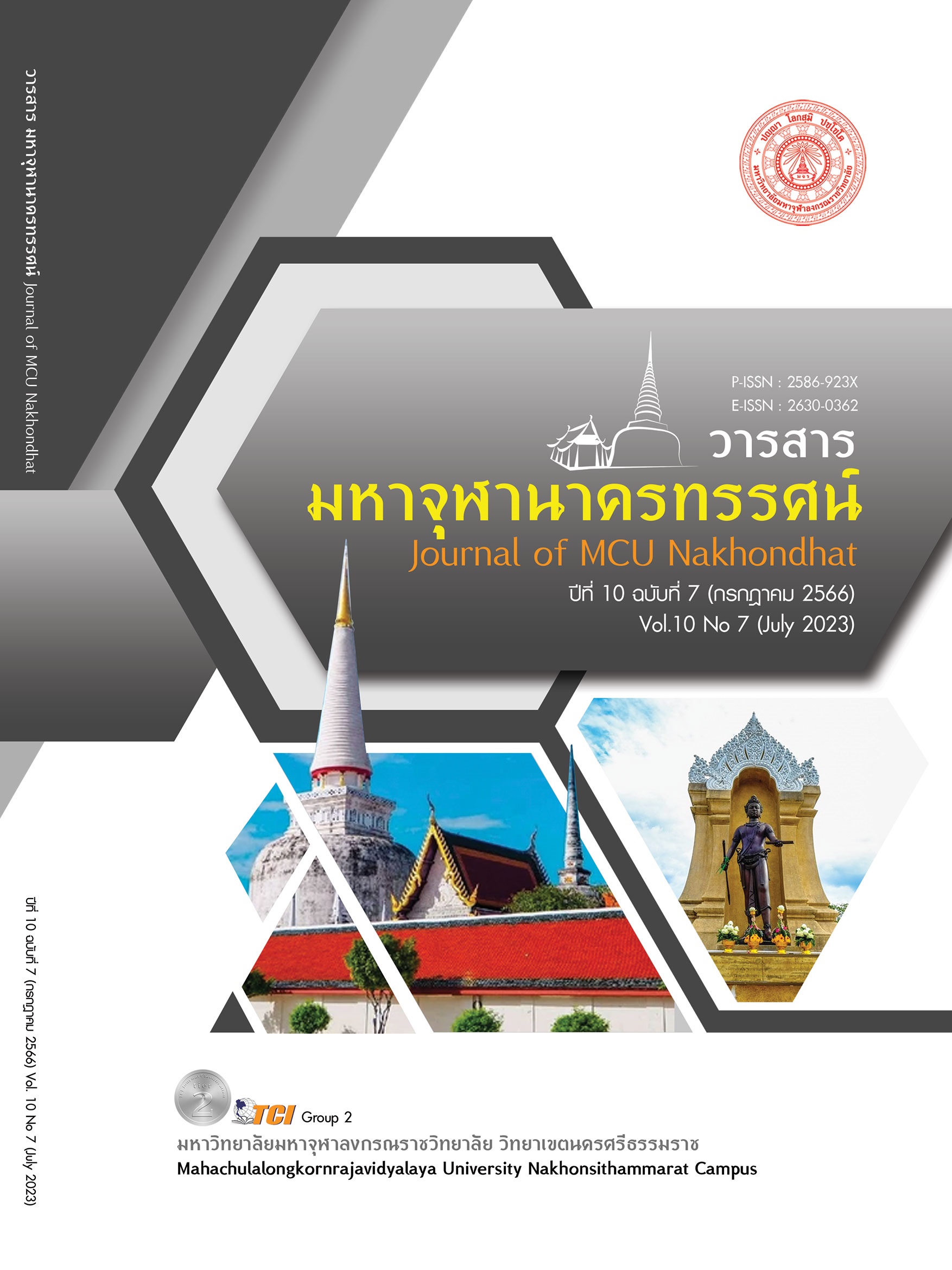การพัฒนาคุณภาพชีวิตผู้สูงอายุตำบลวังหมัน อำเภอวัดสิงห์ จังหวัดชัยนาท
Main Article Content
บทคัดย่อ
การวิจัยครั้งนี้มีวัตถุประสงค์เพื่อ 1) ศึกษาคุณภาพชีวิตของผู้สูงอายุ ตำบลวังหมัน อำเภอวัดสิงห์ จังหวัดชัยนาท 2) สำรวจข้อมูลประชากรผู้สูงอายุ และ 3) สร้างรูปแบบการพัฒนาคุณภาพชีวิตเชิงพุทธบูรณาการของผู้สูงอายุ การวิจัยเป็นแบบผสานวิธีประกอบด้วยการวิจัยเชิงปริมาณและเชิงคุณภาพ กลุ่มตัวอย่าง คือ ผู้สูงอายุในตำบลวังหมัน อำเภอวัดสิงห์ จังหวัดชัยนาท จำนวน 8 หมู่บ้าน หาขนาดของกลุ่มตัวอย่างจากการคำนวณของYamane และได้ระดับความเชื่อมั่น 90% จำนวน 88 คน เครื่องมือการวิจัย ได้แก่ แบบสอบถาม แบบสัมภาษณ์กึ่งโครงสร้าง วิเคราะห์ข้อมูลเชิงปริมาณ โดยหาค่าความถี่ ค่าร้อยละ ค่าเฉลี่ย และส่วนเบี่ยงเบนมาตรฐาน การศึกษาเชิงคุณภาพ ใช้แบบสอบถามแบบกึ่งโครงสร้างเป็นเครื่องมือ เก็บข้อมูลด้วยการสนทนากลุ่ม และสัมภาษณ์เชิงลึก วิเคราะห์ข้อมูลด้วยการวิเคราะห์เนื้อหาและตรวจสอบคุณภาพด้วยเทคนิคสามเส้า ผลการวิจัย พบว่า 1) การศึกษาคุณภาพชีวิตของผู้สูงอายุ ตำบลวังหมัน อำเภอวัดสิงห์ จังหวัดชัยนาท พบว่า การส่งเสริมคุณภาพชีวิตผู้สูงอายุตาม 6 มาตรการหลัก คือ 1) การช่วยเหลือจากหน่วยงานในเวลาที่ต้องการความช่วยเหลือ 2) การสำรวจข้อมูลประชากรผู้สูงอายุ พบว่า ด้านสุขภาพ คือ ทานอาหารที่มีประโยชน์ต่อสุขภาพ ด้านสังคม คือ การทำประโยชน์แก่หมู่บ้านตนเอง ด้านจิตวิญญาณ คือ เข้าร่วมกิจกรรมงดเหล้าวันเข้าพรรษา ด้านเศรษฐกิจ คือ ดำเนินชีวิตโดยคิดคำนึงถึงหลักเศรษฐกิจพอเพียง และ 3) รูปแบบการพัฒนาคุณภาพชีวิตของผู้สูงอายุ ตาม 4 องค์ประกอบของชีวิตได้แก่ “การใช้ชีวิตแบบมรรคง่าย ในยุค New Normal” เพื่อพัฒนาคุณภาพชีวิตของผู้สูงอายุ โดยใช้หลักพุทธธรรม คือ “อริยมรรคมีองค์ 8 เป็นฐาน” ได้แก่ การเห็นชอบ การคิดดี กรรพูดดี การทำดี การทำงานสุจริต การมีความเพียร การมีสติ และการมีสมาธิ
Article Details

อนุญาตภายใต้เงื่อนไข Creative Commons Attribution-NonCommercial-NoDerivatives 4.0 International License.
เอกสารอ้างอิง
กุหลาบ รัตนสัจธรรม และคณะ. (2535). การพัฒนารูปแบบที่เหมาะสมในวิธีการดำเนินงานวางแผนพัฒนาคุณภาพชีวิตตามเกณฑ์จำเป็นพื้นฐานในระดับหมู่บ้าน. กรุงเทพมหานคร: โครงการมหาวิทยาลัยโครงการน้ำพระทัยจากในหลวงเพื่อพัฒนาภาคตะวันออกเฉียงเหนือ.
ดวงใจ เปลี่ยนบำรุง. (2540). พฤติกรรมการดูแลตนเองและคุณภาพชีวิตของผู้สูงอายุในจังหวัดชายแดนภาคใต้ของประเทศไทย. นครปฐม: มหาวิทยาลัยมหิดล.
ต้อย คตพระอินทร์. (25 กันยายน 2565). หลังการใช้รูปแบบการพัฒนาคุณภาพชีวิตเชิงพุทธบูรณาการของผู้สูงอายุ. (ปัตถนะ สิงห์ซอม, ผู้สัมภาษณ์)
นริสา วงศ์พนารักษ์ และสายสมร เฉลยกิตติ. (2557). ภาวะซึมเศร้า: ปัญหาสุขภาพจิตสำคัญในผู้สูงอายุ. วารสารพยาบาลทหารบก, 15(3), 24-30.
บริบูรณ์ พรพิบูลย์. (2558). โลกยามชราและการเตรียมตัวเพื่อเป็นสุข. เชียงใหม่: โรงพิมพ์พระสิงห์การพิมพ์.
ผู้สูงอายุตำบลวังหมัน. (20 สิงหาคม 2563). สภาพคุณภาพชีวิตของผู้สูงอายุ. (ปัตถนะ สิงห์ซอม, ผู้สัมภาษณ์)
ภัทรธิรา ผลงาม. (2561). การส่งเสริมคุณภาพชีวิตผู้สูงอายุในจังหวัดเลย. วารสารประชากรศาสตร์, 34(2), 56-75.
สำนักงานสาธารณสุขจังหวัดชัยนาท. (2562). ผู้สูงอายุที่มาเข้ารับบริการ. เรียกใช้เมื่อ 15 มิถุนายน 2563 จาก https://cnt.hdc.moph.go.th/hdc/reports
องค์การบริหารส่วนตำบลวังหมัน. (2563). สภาพทั่วไป. เรียกใช้เมื่อ 12 มิถุนายน 2563 จาก https://www.wangmun-chainat.go.th/social.php
อภินันท์ สนน้อย และคณะ. (2559). รูปแบบการพัฒนาคุณภาพชีวิตของผู้สูงอายุในจังหวัดบุรีรัมย์. วารสารวิชาการ มหาวิทยาลัยราชภัฏบุรีรัมย์, 8(2), 153-169.
อาวุธ อมรทวีสิน และคณะ . (2562). การพัฒนายุทธศาสตร์การส่งเสริมคุณภาพชีวิตของผู้สูงอายุในจังหวัดเลย. วารสารมนุษยศาสตร์และสังคมศาสตร์ (สทมส.), 25(4), 111-125.
Lawton, M. & Brody, E. (1969). “Assessment of older people: self-maintaining and instrumental activities of daily living”. Journal Gerontologist, 9(3), 179-186.
Yamane, T. (1973). Statistics: an introductory analysis. New York: Harper & Row.


